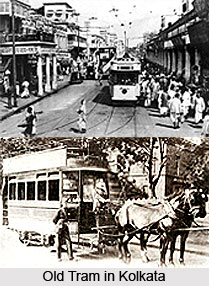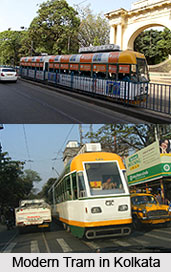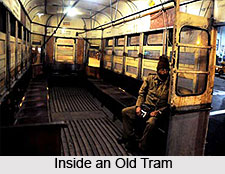 Kolkata Tram System is a system of transportation in urban areas of Kolkata. It came into existence from British era. From the time of British imperialism, tram came to Kolkata, with an imitation of tram transportation system of Italy. Now, after the independence of India in the year 1947, Kolkata tram system is maintained by Calcutta Tramways Company or CTC. The tram system of Calcutta Tramways Company is operating tram network in Kolkata and the oldest operating electric tram in Asia, running since 1902.
Kolkata Tram System is a system of transportation in urban areas of Kolkata. It came into existence from British era. From the time of British imperialism, tram came to Kolkata, with an imitation of tram transportation system of Italy. Now, after the independence of India in the year 1947, Kolkata tram system is maintained by Calcutta Tramways Company or CTC. The tram system of Calcutta Tramways Company is operating tram network in Kolkata and the oldest operating electric tram in Asia, running since 1902.
History of Kolkata Tram System
In 1873, Kolkata tram line began its journey with an attempt to run a 2.4-mile (3.9 km) tramway service between Sealdah and Armenian Ghat Street on 24th February. The service was not adequately patronised, and was discontinued on 20th November 1873. In 1880, the Calcutta Tramway Company Ltd was formed and registered in London on 22nd December. The Metre-gauge horse-drawn tram tracks were laid from Sealdah Station to Armenian Ghat via Bowbazar Street, Dalhousie Square and Strand Road. The route was inaugurated by the Viceroy of Bengal at that time, Lord Ripon, on 1st November.
 The Steam locomotives were deployed experimentally in 1882 to haul tram cars. By the end of the nineteenth century Calcutta Tramway Company Ltd owned 166 tram cars, 1000 horses, seven steam locomotives and 19 miles of tram tracks. During 1900, the electrification of the tramway, and reconstruction of tracks to 4 ft 8 1/2 in (1,435 mm) (standard gauge) began to happen. The first electric tramcar in Asia ran in the year 1902 from Esplanade to Kidderpore on 27th March, and on 14th June from Esplanade to Kalighat. In the year 1951, with the help of Government of West Bengal, Calcutta Tramways Company came into an agreement under Calcutta Tramways Act of 1951. From that time onwards, the Government of West Bengal began to maintain the Kolkata Tram ways till now on.
The Steam locomotives were deployed experimentally in 1882 to haul tram cars. By the end of the nineteenth century Calcutta Tramway Company Ltd owned 166 tram cars, 1000 horses, seven steam locomotives and 19 miles of tram tracks. During 1900, the electrification of the tramway, and reconstruction of tracks to 4 ft 8 1/2 in (1,435 mm) (standard gauge) began to happen. The first electric tramcar in Asia ran in the year 1902 from Esplanade to Kidderpore on 27th March, and on 14th June from Esplanade to Kalighat. In the year 1951, with the help of Government of West Bengal, Calcutta Tramways Company came into an agreement under Calcutta Tramways Act of 1951. From that time onwards, the Government of West Bengal began to maintain the Kolkata Tram ways till now on.
Modern Tram Route in Kolkata
After independence of India, the modern tram routes spider the whole Kolkata with its glory. From North to South Kolkata and from Central to East Kolkata, Kolkata Tram System is giving the service to the people of Kolkata. The tram routes in Kolkata are
| Belgachia - BBD Bag |
| Shyambazar - Esplanade |
| Shyambazar - BBD Bag |
| Bagbazar to BBD Bag |
| Shyambazar - BBD Bag |
| Belgachhia to Howrah Bridge |
| Belghachia - Esplanade |
| Esplanade - Galiff Street |
| Rajabazar to BBD Bag |
| Rajabazar to Howrah Bridge |
| Bidhan Nagar to BBD Bag |
| Bidhan Nagar to Esplanade |
| Bidhan Nagar - Howrah Bridge |
| Park Circus - Howrah Bridge |
| Park Circus - Bidhan Nagar |
| Park Circus - Howrah Bridge |
| Park Circus - Esplanade |
| Tollygunge - Kalighat (short) |
| Gariahat - Esplanade |
| Gariahat to Howrah Bridge |
| Gariahat to Bidhan Nagar |
| Tollygunge - Esplanade |
| Kidderpore to Esplanade |
| Kidderpore - Esplanade and Bagbazar |
 The Esplanade terminus has the most tram routes dissecting North, Central and South Kolkata.
The Esplanade terminus has the most tram routes dissecting North, Central and South Kolkata.



















